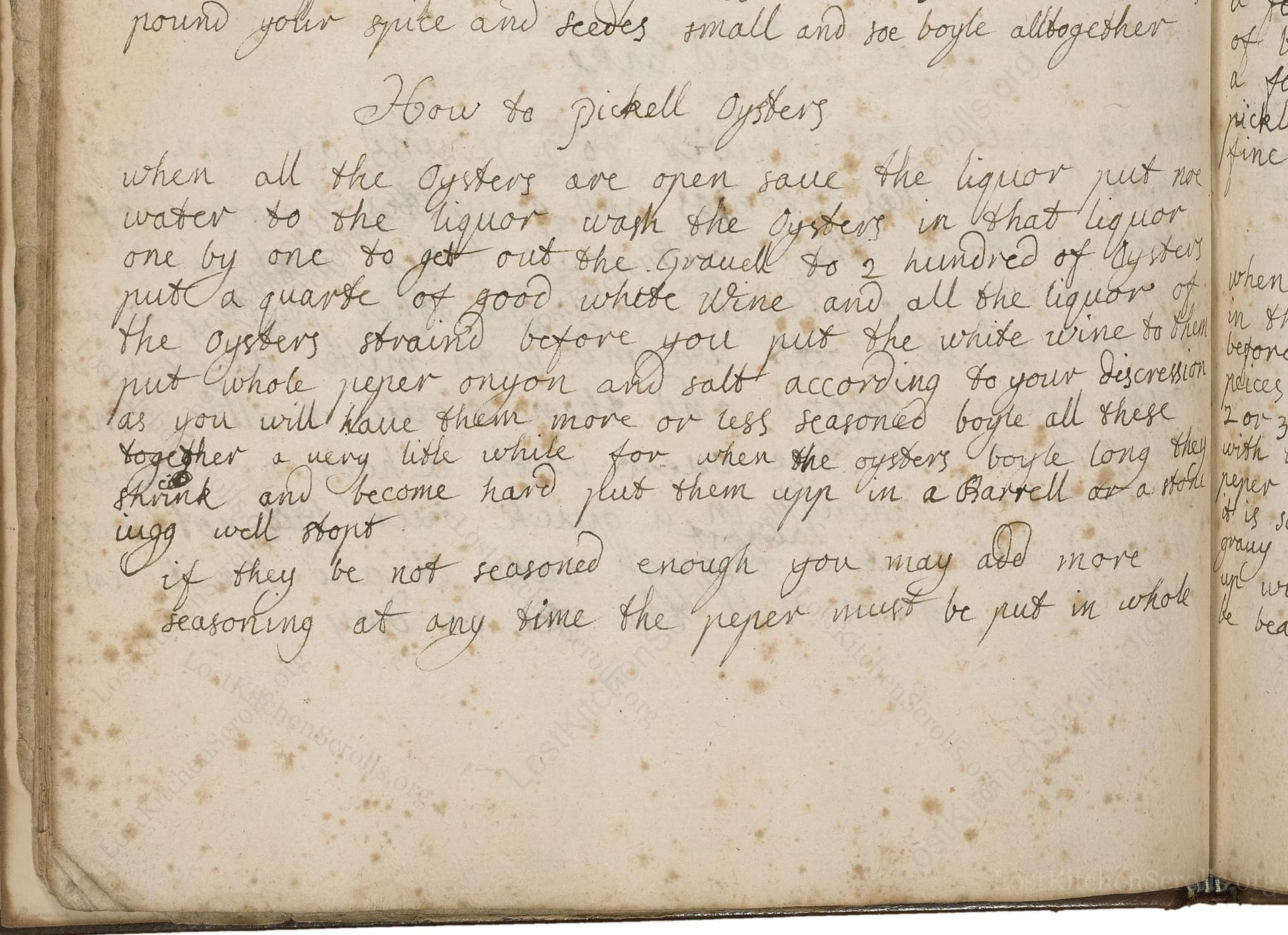How To Pickell Oysters
From the treasured pages of Receipt book
Unknown Author

How To Pickell Oysters
"when all the Oysters are open saue the liquor put noe water to the liquor wash the Oysters in that liquor one by one to gett out the gravell to 2 hundred of Oysters put a quarte of good white wine and all the liquor of the oysters straind before you put the white wine to them put whole peper onyon and salt according to your descression las you will have them more or less seasoned boyle all these together a very litle while for when the oysters boyle long they shrink and become hard put them upp in a Barrell or a stone mugg well stopt if they be not seasoned enough you may add more seasoning at any time the peper must be put in whole"
Note on the Original Text
This recipe is a fine example of early modern English cookery writing: little punctuation, variable spelling ('boyle' for 'boil', 'peper' for 'pepper', 'liquor' for oyster juice). Amounts are imprecise, with much left to the cook's 'discression' (discretion) and taste. Cooking times are minimal, recognizing that over-boiled oysters become tough. The instructions assume kitchen skill and flexibility, inviting the cook to season and perfect over time.

Title
Receipt book (1700)
You can also click the book image above to peruse the original tome
Writer
Unknown
Era
1700
Publisher
Unknown
Background
A delightful glimpse into the kitchens of the early 18th century, this historic culinary manuscript promises a feast of recipes, remedies, and perhaps a pinch of mystery. Expect both practical fare and elegant inspiration for the curious cook.
Kindly made available by
Folger Shakespeare Library
This recipe dates from around 1700 and comes from a household manuscript, reflecting the methods used in English country kitchens of the early modern period. Pickling was a key method of preserving seafood before refrigeration, extending the bounty of oyster harvests well beyond their season. Oysters were a staple for many in Britain at the time, consumed by people across social classes. Recipes like this allowed them to be stored for several weeks, retaining their flavor and texture in an era when fresh food was not always available year-round.

In the early 18th century, oysters would have been opened using sturdy knives well-suited to tough shells. Liquor was strained through a fine cloth or sieve to clear out sand and debris. The boiling and pickling would be done in a large metal, copper, or ceramic pot over a fire or hearth. Finished oysters were packed into ceramic or stoneware crocks, tightly sealed with a stopper or cloth and wax, to keep air out and preserve freshness.
Prep Time
1 hr 30 mins
Cook Time
2 mins
Servings
10
We've done our best to adapt this historical recipe for modern kitchens, but some details may still need refinement. We warmly welcome feedback from fellow cooks and culinary historians — your insights support the entire community!
Ingredients
- 200 fresh oysters (approx. 13-13.25 lb in shells, yielding about 4.5-6.5 lb meat)
- 3 1/4 cups dry white wine
- Strained oyster liquor (from opened oysters)
- 1 whole onion, peeled
- 10-15 whole black peppercorns
- 2-3 tablespoons salt, or to taste
Instructions
- Start by opening fresh oysters (about 200) and reserve all the liquid from inside the shells—this is the oyster liquor.
- Do not add any water.
- Wash each oyster individually in this strained liquor to remove any sand or gravel.
- In a large pot, combine the strained oyster liquor, about 3 1/4 cups of good quality dry white wine, several whole black peppercorns, one peeled and whole onion, and enough salt to taste (start with about 2-3 tablespoons for this quantity, adjusting as you go—taste and season as desired).
- Add the cleaned oysters to the pot.
- Bring the mixture gently to a simmer and cook just briefly—1 to 2 minutes—being careful not to overcook, as the oysters will shrink and toughen.
- Pack the oysters and their liquor into a sterilized stone or glass jar with a tight seal or stopper.
- If after tasting the pickling liquor you need more seasoning, you may add more salt, white wine, or pepper.
- Leave the whole peppercorns in for flavor.
- Allow to cool and refrigerate if not consuming immediately.
Estimated Calories
150 per serving
Cooking Estimates
Opening and cleaning the oysters takes some time, but actual cooking is very quick—just enough to heat them through without making them tough. The prep time is longer because of cleaning each oyster. The calories are based on a typical serving of oysters, wine, and seasoning. This recipe makes around 10 servings.
As noted above, we have made our best effort to translate and adapt this historical recipe for modern kitchens, taking into account ingredients nowadays, cooking techniques, measurements, and so on. However, historical recipes often contain assumptions that require interpretation.
We'd love for anyone to help improve these adaptations. Community contributions are highly welcome. If you have suggestions, corrections, or cooking tips based on your experience with this recipe, please share them below.
Join the Discussion
Rate This Recipe
Dietary Preference
Main Ingredients
Culinary Technique
Occasions

Den Bockfisch In Einer Fleisch Suppen Zu Kochen
This recipe hails from a German manuscript cookbook compiled in 1696, a time whe...

Die Grieß Nudlen Zumachen
This recipe comes from a rather mysterious manuscript cookbook, penned anonymous...

Ein Boudain
This recipe comes from an anonymous German-language manuscript cookbook from 169...

Ein Gesaltzen Citroni
This recipe, dating from 1696, comes from an extensive anonymous German cookbook...
Browse our complete collection of time-honored recipes



